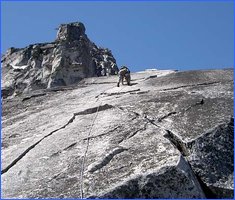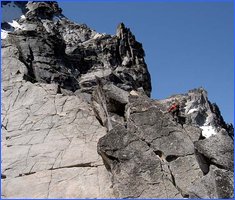Guided Mt. Stuart Climbs
Situated in the Alpine Lakes Wilderness, Mt. Stuart rises over 5000 feet above the surrounding terrain and is home to a variety of challenging alpine climbing routes. Mount Stuart's upper North Ridge is listed as one of the Fifty Classic Climbs in North America and offers intermediate rock climbers a moderate, often delightfully exposed, and enjoyable route to the summit. This is the route that we most often guide on Mt. Stuart. While most of the climbing is in the 5.5 to 5.6 range, the Great Gendarme is encountered about 2/3rds height on the ridge and involves two challenging pitches of 5.9. For climbers uncomfortable at this grade, we have the option to rappel and avoid the crux pitches on easier, but generally wet terrain. Situated just 8 miles from the Northwest Mountain School office in Leavenworth, the North Ridge of Mt. Stuart is one of our signature climbs. We guide this peak often, perhaps more often than anyone, and over the years we have figured out one of the most reasonable ways to take guided climbers up the route.
Mt. Stuart North Ridge Climb Itinerary
For most of the year the most logical descent from the summit of Mt. Stuart is down the Cascadian Couloir on the south side of the mountain. Access to the North Ridge of Stuart requires climbers to approach from either Lake Ingalls and Stuart Pass, or from Mountaineers Creek. With either choice you must ultimately hike halfway around the peak on either the approach or descent. Solutions to this dilemma include either a long day of climbing (18 hours) round-trip from Stuart Pass, or climbing the route with bivy gear and dealing with a heavier backpack. For slower parties it seems to make sense to carry ultrlight bivy gear, spend the first night at Goat Pass, spend the second night on the descent from the summit, and finally hike to your car on the third day. Stronger parties can usually hammer the route out in one or two big days, but most of our guided climbs take 3 or 4 days. We have given examples of itineraries below to help you decide how to tackle the North Ridge of Stuart.Sample Stuart North Ridge 3-day Itinerary:
Day 1: Park at Ingalls Lake Trailhead, hike to bivy at Goat Pass.
Day 2: Traverse over Stuart Pass, and then Goat Pass, climb to North Ridge Notch, ascend North Ridge to summit, descend and bivy at dark.
Day 3: Finish descent and exit.
Day 2: Traverse over Stuart Pass, and then Goat Pass, climb to North Ridge Notch, ascend North Ridge to summit, descend and bivy at dark.
Day 3: Finish descent and exit.
Sample Stuart North Ridge 4-Day Itinerary:
Day 1: Park at Ingalls Lake Trailhead, hike to bivy site north of Ingalls Lake.
Day 2: Traverse over Stuart Pass, and then Goat Pass, climb to North Ridge Notch bivy.
Day 3: Ascend North Ridge to summit, descend Cascadian Couloir, hike back up to bivy.
Day 4: Exit
Day 2: Traverse over Stuart Pass, and then Goat Pass, climb to North Ridge Notch bivy.
Day 3: Ascend North Ridge to summit, descend Cascadian Couloir, hike back up to bivy.
Day 4: Exit
Mt. Stuart North Ridge Qualifications
Excellent physical fitness, solid belaying skills, previous ice axe and crampon experience, ability to climb 5.8 or 5.9 (depending on route taken at Great Gendarme) quickly, smoothly, and efficiently.Unless participants can provide a reference from another guide we know, we will want to climb with you for a day in advance of your Mount Stuart North Ridge climb to confirm your ability to move quickly and efficiently on this long alpine rock climb. As a warm-up you might consider joining us to climb Outer Space (5.9) or Orbit (5.8+) on Snow Creek Wall. Those planning to camp on the route will need very specific lightweight equipment.
Other Routes Northwest Mountain School Guides on Mt. Stuart
- Complete North Ridge (V, 5.9)
- Ice Cliff Glacier (III-V, 50° snow)
- Stuart Glacier Couloir (IV, 80° ice)
- Sherpa Glacier (III, 40° snow)
- West Ridge (IV, 5.6)
We don't get many requests for guided ski descents of Mt. Stuart, but we do have AMGA certified Ski Guides available should you have a desire to ski from near the summit in the Spring. Possible descent routes include the Cascadian Couloir or the Sherpa Glacier.
Interesting Facts about Mt. Stuart
Mount Stuart is one of the largest exposed masses of granite in the United States. It is the second highest non-volcanic peak in the Cascade Range. The highest is Bonaza Peak, which is also located in Chelan County. It is unclear who made the first ascent of Mt. Stuart. On an early ascent of the mountain a stick was rumored to be found near the summit with the inscription Angus McPherson - 1873. A man named A. H. Sylvester made ascents in both 1897 and 1899. He felt that the first ascent was probably made by Richard Goode and Frank Tweedy in the mid to late 1880's. Down low on Mt. Stuart the rock is generally sound, but as you get closer to the summit on both North and South side routes there are areas of loose rock. Recently there were efforts to place a large, underground science lab underneath nearby Mt. Cashmere, capitalizing on the massive amount of granite that makes up the Northern Stuart Range.
















